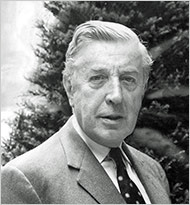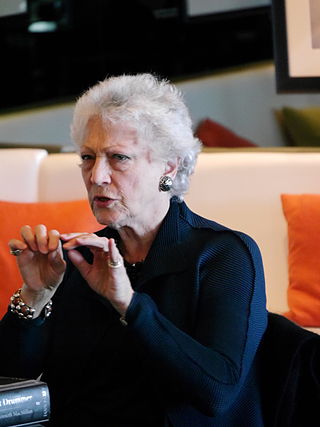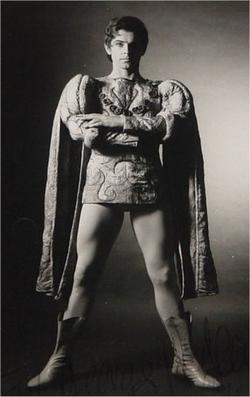Related Research Articles

Sir Frederick William Mallandaine Ashton was a British ballet dancer and choreographer. He also worked as a director and choreographer in opera, film and revue.

Dame Monica Margaret Mason is a former ballet dancer, teacher, and director of The Royal Ballet. In more than a half-century with the company, she established a reputation as a versatile performer, a skilled rehearsal director, and a capable administrator.

Sir Kenneth MacMillan was a British ballet dancer and choreographer who was artistic director of the Royal Ballet in London between 1970 and 1977, and its principal choreographer from 1977 until his death. Earlier he had served as director of ballet for the Deutsche Oper in Berlin. He was also associate director of the American Ballet Theatre from 1984 to 1989, and artistic associate of the Houston Ballet from 1989 to 1992.
Sir Anthony James Dowell is a retired British ballet dancer and a former artistic director of the Royal Ballet. He is widely recognized as one of the great danseurs nobles of the twentieth century.
Dame Merle Park, is a British ballet dancer and teacher, now retired. As a prima ballerina with the Royal Ballet during the 1960s and 1970s, she was known for "brilliance of execution and virtuoso technique" as well as for her ebullience and charm. Also admired for her dramatic abilities, she was praised as an actress who "textured her vivacity with emotional details."
Top of the Form was a BBC radio and television quiz show for teams from secondary schools in the United Kingdom which ran for 38 years, from 1948 to 1986.
Choreographer Sir Kenneth MacMillan's Royal Ballet production of Sergei Prokofiev's Romeo and Juliet premiered at the Royal Opera House, Covent Garden on 9 February 1965.
Pas de légumes is a ballet created in 1982 with choreography by Frederick Ashton, to the music of Rossini arranged by John Dalby.
Les Rendezvous is a plotless one-act ballet created in 1933, with choreography by Frederick Ashton to the music of Daniel Auber arranged by Constant Lambert and with designs by William Chappell. It was the first major ballet created by Ashton for the Vic-Wells company.
Alexander Marshall Grant was a New Zealand ballet dancer, teacher, and company director. After moving to London as a young man, he became known as "the Royal Ballet's most remarkable actor-dancer in its golden period from the 1940s to the 1960s."
A Month in the Country is a narrative ballet created in 1976 with choreography by Frederick Ashton, to the music of Frédéric Chopin arranged by John Lanchbery. It is based on the play by Ivan Turgenev of the same name, and lasts for about 40 minutes.
Les Patineurs is a ballet choreographed by Frederick Ashton to music composed by Giacomo Meyerbeer and arranged by Constant Lambert. With scenery and costumes designed by William Chappell, it was first presented by the Vic-Wells Ballet at the Sadler's Wells Theatre, London, on 16 February 1937. It has been called "a paradigm of an Ashton ballet, perfectly crafted with a complex structure beneath the effervescent surface."
The Dream is a one-act ballet adapted from Shakespeare's A Midsummer Night's Dream, with choreography by Frederick Ashton to music by Mendelssohn arranged by John Lanchbery. It was premiered by The Royal Ballet at the Royal Opera House, Covent Garden on 2 April 1964 in a triple bill with Kenneth MacMillan's Images of Love and Robert Helpmann's Hamlet.
Enigma Variations (My Friends Pictured Within) is a one-act ballet by Frederick Ashton, to the music of the Variations on an Original Theme (Enigma Variations), Op. 36, by Edward Elgar. The work was first given by the Royal Ballet at the Royal Opera House, Covent Garden, London, on 25 October 1968. It has been revived in every subsequent decade.

Derek Rencher was a British ballet dancer. A commanding figure among Royal Ballet character dancers for more than four decades, he was probably the most prolific performer in the company's history.
Symphonic Variations is a one-act ballet by Frederick Ashton set to the eponymous music of César Franck. The premiere, performed by the Sadler's Wells Ballet, took place at the Royal Opera House, Covent Garden, on 24 April 1946 in a triple bill; the other works were Ashton's Les Patineurs and Robert Helpmann's Adam Zero. The ballet was conducted by Constant Lambert and the set designed by Sophie Fedorovitch.
Desmond Doyle was a South African ballet dancer who performed in England in the 1950s and 1960s before becoming ballet master of The Royal Ballet.
Vyvyan Lorrayne was a South African ballet dancer. Noted as a "softly classical stylist," she won acclaim as a principal dancer for England's Royal Ballet during the 1960s and 1970s.
Brian Shaw was a British ballet dancer and teacher. As a leading dancer with the Royal Ballet during the 1950s and 1960s, he was widely regarded as "one of the finest classical male dancers of his generation".
Tiresias is a ballet in a prelude and three acts choreographed by Frederick Ashton to an original score by Constant Lambert. With scenery and costumes designed by the composer's wife Isabel Lambert, it was first presented by the Royal Ballet at the Royal Opera House Covent Garden, London, on 9 July 1951.
References
- 1 2 Vaughan, D. Frederick Ashton and his Ballets. A & C Black Ltd, London, 1977, ISBN 978-0713616897.
- ↑ Bland, A. The Royal Ballet – the first 50 years. Threshold Books, London, 1981, ISBN 9780901366115
- ↑ About The House, Winter 1991, p. 4-5
- 1 2 Kavanagh, J. Secret Muses: The Life of Frederick Ashton. Faber & Faber Ltd, London, 1996, ISBN 9780571143528
- ↑ AG, Universal Edition. "Universal Edition: Sir Richard Rodney Bennett – Jazz Calendar". Universaledition.com. Retrieved 4 August 2017.
- ↑ Fox C. Programme note for Philips recording, 6500 301, 1972.
- ↑ "Jazz Calendar (1968)". Ftvdb.bfi.org.uk. Archived from the original on 29 January 2009. Retrieved 4 August 2017.
- ↑ Williams P, Percival J, Goodwin N. Jazz Calendar (premiere reviews). Dance and Dancers, February 1968; Volume 19:2, pp. 12-17, 22